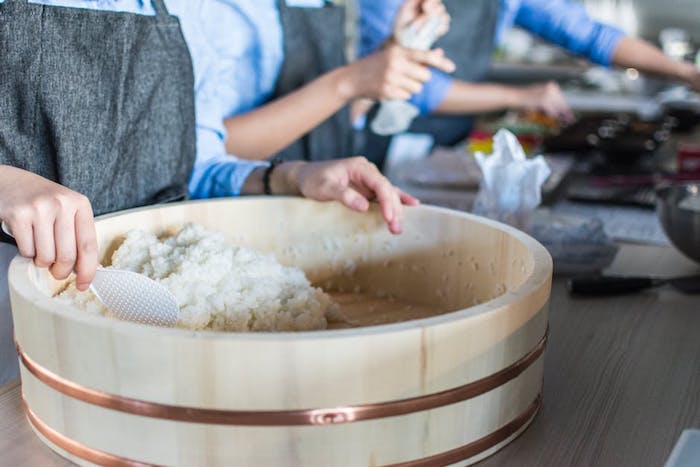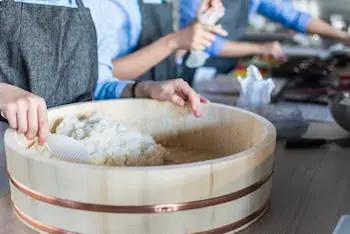We are reader supported. When you purchase through links on our site, we may earn an affiliate commission. Also, as an Amazon affiliate, we earn from qualifying purchases.

I had been wondering how restaurants manage to make great sushi until I did research and found out their secret. It is very simple; the foundation of great sushi is short-grain sushi rice. That is all you need to make tasty sushi dishes.
So, how do you make sushi more sticky? Well, the cooking approach use is the key to making your sushi rice stickier. You need to use the right rice (Short grain), use a little bit more water, give it time to cool and avoid pre-soaking before cooking.
A sushi dish cannot be complete without rice. It doesn’t mean you use any other rice; it needs to be sticky sushi rice. When preparing the rice, you need to use the proper rice like this on my recommended products, cook it the right way and season it properly if you want to make it stickier. Otherwise, you will end up with separated rice that can’t be useful in sushi making.
Unless you follow the instructions to make sticky rice perfectly, you will end up with separated or fluffy rice that can’t be useful in sushi making. Read on to find out more.
Contents
Why Should Sushi Rice be more sticky?
Making sushi rice stickier isn’t a thing you can ignore if you want to be successful in sushi making. Sticky rice is meant to make it be able to hold together and make it possible to make sushi rolls. The stickier the sushi rice, the easier it will be for you to mold it into various shapes.
Grains that don’t stick together cannot be molded into any shape to form a sushi roll or nigiri sushi. If you are a beginner, trying your hand at sushi-making for the first time, this is more important for you to cook rice as sticky as possible. Without that, you will have a hard time trying to give it shape.
How Does Stickiness Form In Sushi Rice?
Are you wondering how the hard rice grains turn into sticky substance? Well, a water-soluble type of starch called amylopectin is the key behind the formation of stickiness in rice. This starch breaks down when exposed to hot water making the structure of the grain to become soft, mushy and sticky.
Short-grain rice contains a very negligible percentage of amylase, hence it is not considered at all. So, how does it turn into such a sticky variety of cooked rice? As amylopectin is the more water-soluble type of starch, it breaks down when exposed to hot water.
As a result, the structure of the grain to become soft, mushy and sticky. Please bear in mind that hot water is an important catalyst in bringing out the sticky texture. If you keep short grains soaked in cold water, nothing will happen. The rice starch molecules break down only when exposed to heat.
Ways to Make Sushi Rice More Sticky
As mentioned before, you are in control of how sticky your sushi will become depending on how you cook it. Below are ways to not only make your sushi stickier but also ensure it remains within the right stickiness range.
1. Avoid rinsing your sushi rice with hot water
Rinsing sushi rice before cooking it is highly recommended. It is meant to wash-off the chemicals that may have been used in its preservation. Some people may opt to use hot water to ensure their rice is safe for cooking.
Well, if you want your sushi to become stickier, this is a thing you should never do. After all, the chemicals used for preservation aren’t so harmful to pose any health risk. When you rinse the rice with hot water, you are interfering with the starch of the grain, how?
The starch responsible for the formation of stickiness can be broken apart by hot water. That means you will be washing it off together with the chemicals you are presuming to be harmful. Always rinse your rice until the water becomes clear but never make the mistake of using hot water if you want your sushi rice to
2. Let it cool
Sushi rice becomes sticky as it cools. You should therefore not be in a hurry to use it after preparing. Give it time to cool to room temperature. It will become stickier as it cools. However, you should not leave it for a long time i.e. overnight. It will not have a good taste as it should have when used within a few hours of preparing.
However, you should not leave it for a long time i.e. overnight. It will not have a good taste as it should have when used within a few hours of preparing. Ideally, you should let the steaming hot sushi rice to cool for a few minutes but use it for making sushi while it’s still warm.
Related Question: Can You Leave Sushi Rice Overnight?
3. Water to rice ratio
When you are cooking other types of rice, you will mostly use the ratio of 1:1 water to rice ratio. However, when it comes to sushi rice, things are different. To make the sushi rice stickier, you need to use water to rice ratio of 1.2: 1.
Don’t go beyond this ratio to avoid getting pasty and sticky rice. The given ratio will give you just enough stickiness to mold the rice into beautiful shapes.
4. Use the Right Rice
Using the right rice to make your sushi is the most crucial step that you should never ignore when you want your rice to become stickier. By right rice, I mean sushi rice only. Don’t just pick any other rice; it won’t work.
Short grain (
When you go to an Asian grocery store to buy sushi rice, ask the shopkeeper for shinmai variety. This is the newest crop of rice from the first harvest and they always contain more starch. As the rice gets older, the starch content also reduces significantly.
5. Use Honey (Not Recommended)
Want an easier way to make your sushi rice stickier? Here you have it. After you are done preparing your sushi rice, add a few tablespoons of honey and leave it covered for around ten minutes. After that, your rice will sticky and ready to get things rolling.
While this is an easy and quick fix method to make your sushi rice stickier, it’s not the most recommended method. By adding honey to rice, you will alter the flavor of cooked rice, and your sushi may not taste the same.
Things to Be Careful With Sticky Sushi Rice
Sticky sushi rice is at is sound – it is tacky! If you aren’t careful, you will end up sticking it to everything in your kitchen. You should, therefore, keep a wet kitchen towel or paper towels nearby when making sushi rolls.
Even if more stickiness is what you are trying to achieve, it may exceed. If your sushi rice becomes too sticky to spread, moistening your fingers with water can ease things.
When making sushi, prepare a cup of Ttezu which includes one cup of water mixed with one tablespoon of rice wine vinegar. Dip your fingers in this solution and even wash your knife in this water to prevent rice grains from sticking.
Five Common Mistakes To Avoid When Cooking Sushi Rice
When you are a beginner, making sushi rice may be an overwhelming experience for you. Trust me that it’s not as hard as it seems. Even if the first attempt does not come out as expected, you will learn from your mistakes and the not-so-perfect sushi will taste good anyway. Here are some common mistakes you must avoid:
#1. Following package directions blindly
The directions you see on the package is just a road map to help you, but it’s not a foolproof plan. Your requirement may vary depending on the pan you use, cooking temperature, humidity, and altitude. Cooking times often increase in areas with higher elevations, so let your senses be the best judge.
#2. Stirring rice too much
Stirring too much will breakdown the rice grains, so just let them be. You will also knock off the starch coating on the outside. When you steam short-grain rice, this will create a layer of starch in the bottom causing the grains to stick and burn.
#3. Cooking on a very high temperature
If you cook sushi rice on a high flame, the pouter layer will cook but the middle area may stay raw and taste really bad. To get the best results and a perfect sticky texture, make sure you cook rice at medium temperature.
#4. Lifting the lid frequently
As a beginner, it’s natural to feel nervous and impatient, but lifting the lid frequently will result in the steam escaping out of the pan. As the steam escapes, the heat or temperature inside the pan drops resulting in your rice not cooking as it should.
#5. Treating brown rice the same way
Brown rice is not the preferred option for making sushi, however, some health-conscious people tend to use it instead. If you want to use brown rice, don’t treat it the same way as white rice. The former will require excess liquid and more cooking time to achieve a sticky texture.
FAQ
If I make my sushi rice stickier, shouldn’t I be worried about it having gluten? I’m very cautious about what I take, and this got me concerned.
You shouldn’t be worried about your rice having gluten. Your rice only becomes sticky and seems like it’s glutinous. However, it’s very safe. You should not be worried that you are risking your life in any way.
Instead of going to all the trouble of making my sushi stickier, why can’t I go for sticky rice?
Even if we are trying to make our sushi rice stickier, it doesn’t mean it will be similar to sticky rice. The two are entirely different regarding texture. When you replace sushi rice with sticky rice, you will end up with sticky rice that won’t work in making sushi dishes.
Why should I go all the trouble of making my sushi stickier when I can add starch to the rice during the process of cooking?
Well, if you are lazy and don’t want to stress yourself in making your sushi rice stickier, you can add the starch to the rice. However, the fun of making sushi rice stickier is not by going through shortcuts; it’s by sweating it all through.
Besides, such rice won’t be as good as one made stickier naturally. Remember the starches you may be adding maybe having a taste hence make your sushi rice taste different.
Related Article: Is Sushi Rice Sticky Rice?
Conclusion
You don’t need any fancy kitchen equipment to make sticky sushi rice. You can follow simple ways and get sticky sushi rice that will help you prepare great sushi dishes.
One important thing you need to know is that you shouldn’t just buy any other rice for your sushi making. If you want to make sushi stickier, go for short (recommend) or medium grain rice only.


Comments
Pingback: How to Clean a Bamboo Sushi Mat? - Easy Homemade Sushi
Pingback: Different Ways To Roll Sushi: The Ultimate Guide - Easy Homemade Sushi
Pingback: Things You Should Know About Eating Sushi - Easy Homemade Sushi
Pingback: How to Make California Rolls at Home Easy? - Easy Homemade Sushi
Pingback: 10 Common Sushi making Mistakes - Easy Homemade Sushi
Pingback: How To Make Sushi Rice In A Rice Cooker ? (also in a pot) - Easy Homemade Sushi